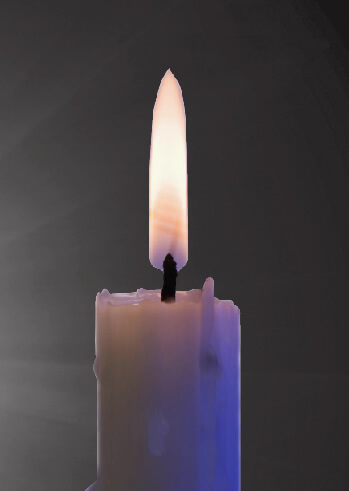“We believe in one Lord, Jesus Christ…
True Light from True Light,
True God from True God.”
(from the Nicene Creed)

The King of Heaven who hurled galaxies across the light years sleeps in a feeding trough for cattle! The infinite, boundless, ineffable God has entered into the whirl of time and history, coming down to become one of us! He has plunged headlong into our world so that He might relate to us not only as Almighty God, but as our Brother and Friend, and our Savior.
This booklet of daily reflections for Advent and Christmas is prepared to assist in our worship of the Lord Jesus Christ, and to ponder the deeper meaning of His coming. Each day’s reading is a reflection on a Scripture text relating to the theme of God’s True Light who has come into our world. In the northern hemisphere the seasons of Advent and Christmas come at the darkest time of the year, so that the natural symbols of light and darkness are powerfully at work throughout these days.
Just as darkness universally symbolizes death and destruction, so light symbolizes life and joy to the fullest. As we string lights on our Christmas trees and houses we celebrate the True Light from True Light who overcomes all darkness. Each time we light a candle, or see a light shining in the darkness, let us re-commit ourselves to following God’s True Light and sharing His Light with others. Jesus is the Light “that shines in the darkness and the darkness has not overcome it” (John 1:5). That is the reason for the season and our joy and celebration.
The Bible plainly proclaims that “God is light” (I John 1:5), and that Jesus is “the light of the world” (John 8:12; 9:5). The coming of Christ into our world shines His “light on those living in darkness and in the shadow of death” (Luke 1:79). And no one is beyond the radiant brightness of Jesus’ life as He is “the true light that gives light to everyone” (John 1:9).
Each of the twenty-nine readings for the Advent Season begins with the symbolic lighting of a candle as we prepare ourselves to listen for God speaking to us in His Word. Then there is a brief Scripture text, a reflection on that text, followed by a moment of silence, and then prayer.
At the end of each of the four weeks of Advent there is a page set aside for “Treasuring Advent”. In this you will have space to both treasure and ponder God’s special gifts to you during these special days. You will likely find that this kind of spiritual practice will add to the joy and meaning of this Advent and Christmas.
The Season of Advent
Whether we are young or old there is something about this time of year that excites joy. Turning to the last page of the old calendar we sense newness stirring within. The wonder and beauty of this special season sweep over us and moments of awe mingle with our daily routine. As we get out the Christmas decorations and string up the lights we feel the Spirit of God moving us in new directions.
Each year more and more people are discovering the joy of celebrating the Advent Season. There is something about its celebration that slows down the rush of the holidays and helps us focus on things that matter most to God and to us.
Advent begins on the fourth Sunday before Christmas Day and culminates on Christmas Eve. It is four weeks of reflecting, paying attention to God, prayer, and joyful expectation. The first Sunday of Advent is actually the New Year’s Day for the Church, and the beginning of a new Church calendar. Thus Advent has long been a time for new beginnings, fresh starts, and experiencing the newness and vitality of life in Christ.
Advent is an old Latin word that means “coming”. It is a term that the early Christians borrowed from their culture, where “advent” meant the “coming” of news of victory, or the “coming” of the emperor for a state visit. Advent was a time of rejoicing and celebration as people gathered at the city gates to celebrate the coming of “salvation” and “peace”. The early church thought it fitting to use the term “advent” for the celebration of Christ’s coming, bringing salvation and peace to the world.
It is significant that the Latin word “advent” was a translation of the Greek word parousia that early Christians used to talk about: the “coming” of Christ in glory at the end of history. So from its earliest days, the celebration of Advent has had this double focus of looking back to Christ’s coming and looking ahead to His coming again. Thus the season of Advent has always been a time of joyous celebration, preparation, and reflection.
The celebration of Advent across many years and cultures means that there are rich traditions and meanings for us to explore. And because Advent is preparation for Christmas children are usually eager to be a part of the daily celebration with the Advent Wreath, candle lighting, and devotions.
The Advent Wreath is a much loved tradition dating back to 16th century Germany that was quickly welcomed by both Protestants and Catholics alike. The Advent Wreath was brought to America by German immigrants in the 19th century.
An Advent Wreath is simple to prepare, or can be purchased at many department stores and Christian book stores. All that is needed are five candles and some evergreen boughs formed into a circle or wreath. Four of the candles are placed around the wreath with one candle, usually a larger one, placed in the center of the wreath.
The circular shape of the wreath symbolizes the eternity of Christ who is without any beginning or end. The evergreen of the wreath reminds us of the unending, eternal life that Christ brings to us. The four candles around the wreath speak to us of the True Light from True Light shining in Christ Jesus. The candle placed in the center of the wreath is called the Christ Candle. It is lit on Christmas Eve and represents the light of Christ shining at the very heart of our lives.
One candle is lit on the first Sunday of Advent and each day of the first week. Then two candles are lit on the Second Sunday and week of Advent, three candles on the third week, and all four candles are lit during Advent’s fourth week. The progression of light through the weeks of Advent, symbolizes the darkness of sin and death giving way to the coming of God’s True Light into the world. Many people will light the candles all the way through to New Year’s Day to proclaim the light of Christ that goes with them into the New Year.
In the home, the Advent Wreath is often placed on the dining table and the candles lit at mealtime, with time for reading from Scripture and a devotional such as “True Light from True Light”. Children usually jump at the opportunity to light the candles and to read the prayer. The daily practice of Advent can encourage both young and old to set aside time each day in the New Year for Bible reading, reflection and prayer. This can be a meaningful “gift” that we take with us into the New Year.
As it has so often, Advent comes this year at a time of economic uncertainty, political discord, wars around the world, and grave concern for our future. Not at all unlike the days when the Christ Light first shined into our world. But through the centuries people have experienced new peace and purpose in taking time each day for celebrating Advent and the coming of True Light from True Light.



